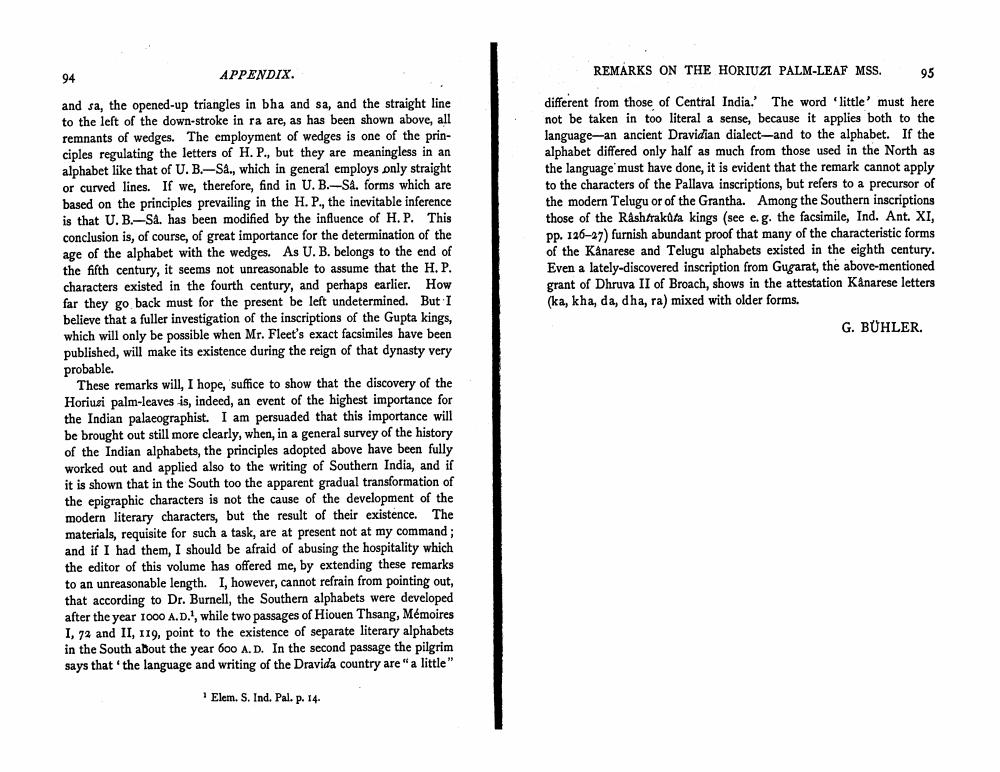________________ APPENDIX. 94 REMARKS ON THE HORIUZI PALM-LEAF MSS. 95 different from those of Central India. The word 'little' must here not be taken in too literal a sense, because it applies both to the language-an ancient Dravidian dialect--and to the alphabet. If the alphabet differed only half as much from those used in the North as the language must have done, it is evident that the remark cannot apply to the characters of the Pallava inscriptions, but refers to a precursor of the modern Telugu or of the Grantha. Among the Southern inscriptions those of the Rashtrakuta kings (see e.g. the facsimile, Ind. Ant. XI, pp. 126-27) furnish abundant proof that many of the characteristic forms of the Kanarese and Telugu alphabets existed in the eighth century. Even a lately-discovered inscription from Gugarat, the above-mentioned grant of Dhruva II of Broach, shows in the attestation Kanarese letters (ka, kha, da, dha, ra) mixed with older forms. G. BUHLER. and sa, the opened-up triangles in bha and sa, and the straight line to the left of the down-stroke in ra are, as has been shown above, all remnants of wedges. The employment of wedges is one of the principles regulating the letters of H. P., but they are meaningless in an alphabet like that of U. B.-Sa., which in general employs only straight or curved lines. If we, therefore, find in U. B.-Sa. forms which are based on the principles prevailing in the H.P., the inevitable inference is that U. B.-Sa. has been modified by the influence of H.P. This conclusion is, of course, of great importance for the determination of the age of the alphabet with the wedges. As U. B. belongs to the end of the fifth century, it seems not unreasonable to assume that the H. P. characters existed in the fourth century, and perhaps earlier. How far they go back must for the present be left undetermined. But I believe that a fuller investigation of the inscriptions of the Gupta kings, which will only be possible when Mr. Fleet's exact facsimiles have been published, will make its existence during the reign of that dynasty very probable. These remarks will, I hope, suffice to show that the discovery of the Horiuzi palm-leaves is, indeed, an event of the highest importance for the Indian palaeographist. I am persuaded that this importance will be brought out still more clearly, when, in a general survey of the history of the Indian alphabets, the principles adopted above have been fully worked out and applied also to the writing of Southern India, and if it is shown that in the South too the apparent gradual transformation of the epigraphic characters is not the cause of the development of the modern literary characters, but the result of their existence. The materials, requisite for such a task, are at present not at my command; and if I had them, I should be afraid of abusing the hospitality which the editor of this volume has offered me, by extending these remarks to an unreasonable length. I, however, cannot refrain from pointing out, that according to Dr. Burnell, the Southern alphabets were developed after the year 1000 A.D.?, while two passages of Hiouen Thsang, Memoires I, 72 and II, 119, point to the existence of separate literary alphabets in the South about the year 600 A.D. In the second passage the pilgrim says that the language and writing of the Dravida country are "a little" 1 Elem. S. Ind. Pal. p. 14.




